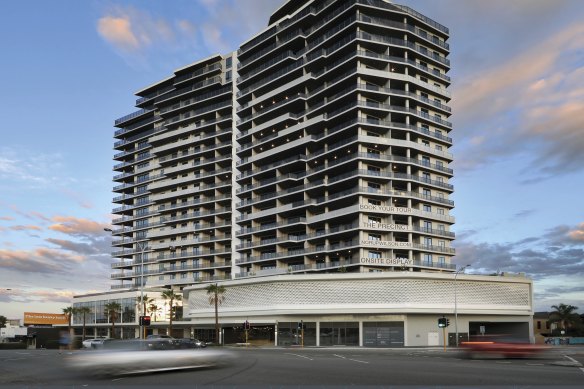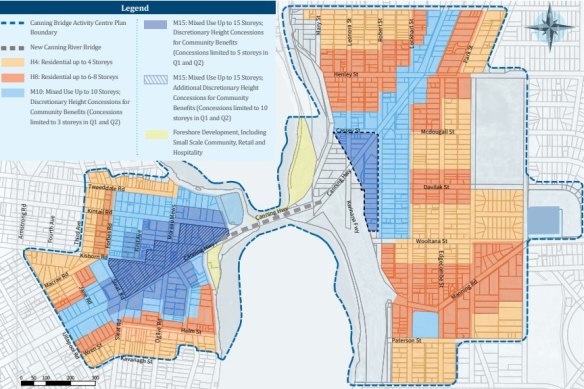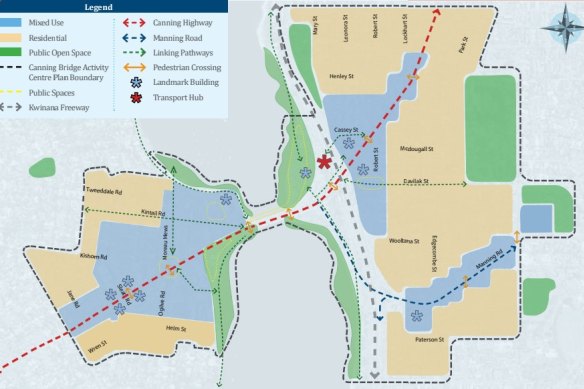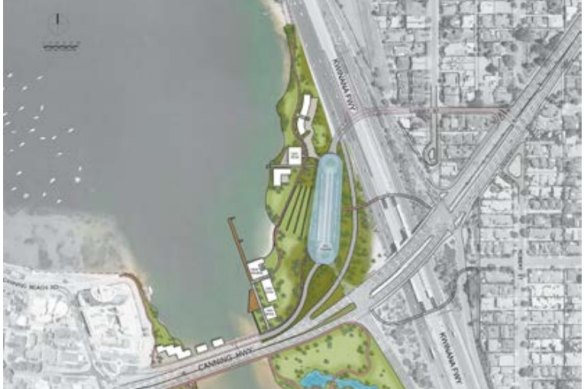By Emma Young
One of Perth’s highest profile planning firms has had a crack at solving deep dissent over building controls in a redevelopment precinct forming a key Perth city gateway: Canning Bridge.
Rezonings have so far encouraged a spattering of high-rise towers along Canning Highway in Applecross and Mount Pleasant that have not created the humming city outpost envisioned.

The 192-apartment The Precinct was completed some time ago but the numerous ground floor tenancies remain mostly vacant.Credit: Norup Wilson
Development on the South Perth side has so far been mostly medium-height apartments in Como, numerous but much less prominent than those near the Raffles that dominate the views of traffic on the bridge.
After tweaks in 2019 on both councils’ sides failed to resolve “overwhelming community discontent” and distrust a review was outsourced in 2020 to Hatch Roberts Day.
Surveys, roundtables, workshops and consultations with all the state agencies concerned have led to this new draft activity centre plan out for public comment.
The council also invited a corresponding report from a community group representing those affected by development thus far.
Just on the Melville side, there have been approved or built five towers from 20-30 storeys and three from 13-16, all representing “bonus” height supposed to be awarded to exemplary designs that provide community benefits.
“The alleged community benefits that have been provided for these bonus storeys are almost exclusively largely underutilised and unwanted community meeting rooms and end-of-trip public showers and bicycle parking facilities,” the community group’s report said.
“[The developments] can best be described as ordinary.”
A sore point has been the area’s lack of parkland apart from narrow stretches of foreshore that are at some points hard to access and distinctly unloved, and a shared path already crammed with walkers and cyclists.
Another is the scarcity of commercial tenants for promised ground-floor “activations” in the apartments already built, leading to a quiet, glassy streetfront with little greenery and lacking a promised “piazza”.

The Canning Bridge activity centre plan draft 2022.Credit: City of Melville
The community group also wrote the aim of “affordable housing” in this area had been proved unrealistic.
High costs of developing here led to high apartment costs – one-bedroom apartments in the area started at $465,000 and buyers could expect to pay an extra $100,000-$250,000 on top of this for a two-bedroom apartment and an extra $1 million or more for a three-bed.
One-bedrooms, despite being mandated as 20 per cent of the buildings, theoretically to provide more affordable housing, had not sold well, the community report said.
Hatch Roberts Day’s draft review caps bonus heights at 25 storeys in the 15-storey zone and tweaks preferred land uses above the ground floor to concentrate commercial activity along the street.
It suggests broadening the definition of “community benefits” so developers can provide these beyond the actual development site, and to satisfy a list of predetermined community desires.
They say on the boundary of the activity centre, that is, where four-storey developments abut traditional single and double-storey homes, designs must be led by an attempt to minimise impact on neighbours, and overshadowing and privacy will be the main approvals issue.
In these areas, they have stipulated minimum setbacks to encourage people to combine lots for bigger projects, rather than have overdeveloped single lots.
In the taller heart they stipulate more slender towers, with more “breathing space” between, and greater setbacks to protect street trees.

Planned building uses in the draft, with landmark buildings asterisked. Credit: City of Melville
They suggest developers should be required to provide 10 per cent of their site as public open space, or pay cash in lieu.
The community group on the whole supported the draft but wanted it to go further, with:
- bonus heights gone and 10 and 15-storey zones to represent actual caps
- green walls and rooftop gardens not be allowed to replace ground floor landscaping requirements
- residents affected by overshadowing on the boundary of the activity centre to be compensated financially
- no requirement for 20 per cent of developments to be one-bedroom
- 4-metre setbacks between large buildings to create 8-metre tree-lined pedestrian lanes
- 20 per cent public open space contributions and no opportunity for cash in lieu
They compared their side to South Perth’s green expanses of lawn, and wrote that parks “could not be replaced by a chequebook”.
While the review focused west of the bridge, the unchanged remainder of the plan provides a peek at the future of the wider area.

The concept sketch for a new elevated bus station on the vacant land north of the bridge. Credit: City of Melville
“Landmark” buildings are expected at the eastern approach to the bridge, and at the large, mostly vacant site currently occupied by the Mt Henry Tavern.
There is a concept plan for a new elevated bus station on a patch of unkempt grass north of the bridge, with surrounding foreshore commercial development and terraced public spaces.
A new traffic bridge is also pencilled in, with the current bridge to be retained as a space for public transport, walking, cycling and pop-up markets.
The comment period closes on October 28. Details here.
Follow WAtoday on Instagram, LinkedIn, Facebook and Twitter for handpicked selections of the day’s biggest local, national and international news.